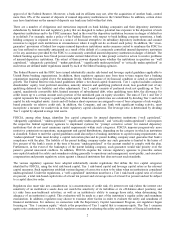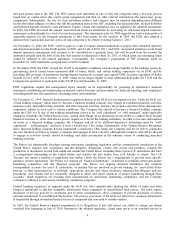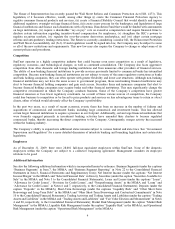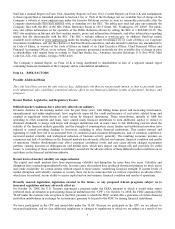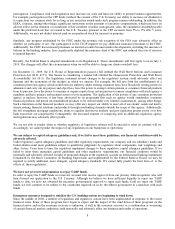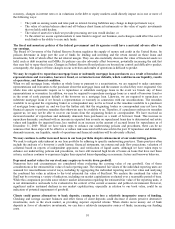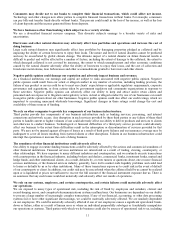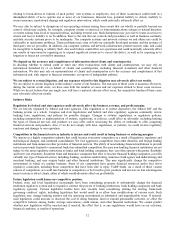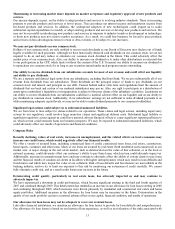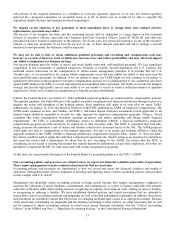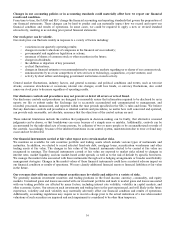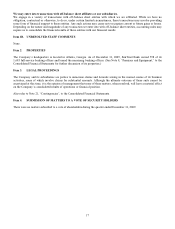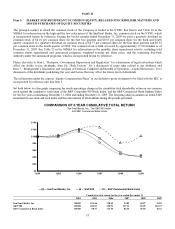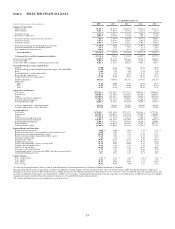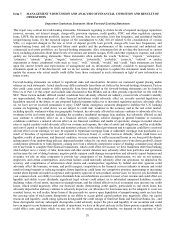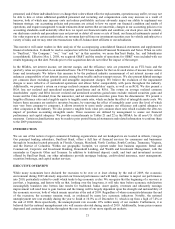SunTrust 2009 Annual Report Download - page 28
Download and view the complete annual report
Please find page 28 of the 2009 SunTrust annual report below. You can navigate through the pages in the report by either clicking on the pages listed below, or by using the keyword search tool below to find specific information within the annual report.relating to break-downs or failures of such parties’ own systems or employees. Any of these occurrences could result in a
diminished ability of us to operate one or more of our businesses, financial loss, potential liability to clients, inability to
secure insurance, reputational damage and regulatory intervention, which could materially adversely affect us.
We may also be subject to disruptions of our operating systems arising from events that are wholly or partially beyond our
control, which may include, for example, computer viruses or electrical or telecommunications outages or natural disasters,
or events arising from local or regional politics, including terrorist acts. Such disruptions may give rise to losses in service to
clients and loss or liability to us. In addition, there is the risk that our controls and procedures as well as business continuity
and data security systems prove to be inadequate. The computer systems and network systems we and others use could be
vulnerable to unforeseen problems. These problems may arise in both our internally developed systems and the systems of
third-party service providers. In addition, our computer systems and network infrastructure present security risks, and could
be susceptible to hacking or identity theft. Any such failure could affect our operations and could materially adversely affect
our results of operations by requiring us to expend significant resources to correct the defect, as well as by exposing us to
litigation or losses not covered by insurance.
We depend on the accuracy and completeness of information about clients and counterparties.
In deciding whether to extend credit or enter into other transactions with clients and counterparties, we may rely on
information furnished by or on behalf of clients and counterparties, including financial statements and other financial
information. We also may rely on representations of clients and counterparties as to the accuracy and completeness of that
information and, with respect to financial statements, on reports of independent auditors.
We are subject to certain litigation, and our expenses related to this litigation may adversely affect our results.
We are subject to certain litigation in the ordinary course of our business. The outcome of these cases is uncertain. However,
during the current credit crisis, we have seen both the number of cases and our expenses related to those cases increase.
While we do not believe that any single case will have a material adverse effect on us, the cumulative burden of these cases
may adversely affect our results.
Industry Risks
Regulation by federal and state agencies could adversely affect the business, revenue, and profit margins.
We are heavily regulated by federal and state agencies. This regulation is to protect depositors, the federal DIF and the
banking system as a whole. Congress and state legislatures and federal and state regulatory agencies continually review
banking laws, regulations, and policies for possible changes. Changes to statutes, regulations, or regulatory policies,
including interpretation or implementation of statutes, regulations, or policies, could affect us adversely, including limiting
the types of financial services and products we may offer and/or increasing the ability of nonbanks to offer competing
financial services and products. Also, if we do not comply with laws, regulations, or policies, we could receive regulatory
sanctions and damage to our reputation.
Competition in the financial services industry is intense and could result in losing business or reducing margins.
We operate in a highly competitive industry that could become even more competitive as a result of legislative, regulatory and
technological changes, and continued consolidation. We face aggressive competition from other domestic and foreign lending
institutions and from numerous other providers of financial services. The ability of non-banking financial institutions to provide
services previously limited to commercial banks has intensified competition. Because non-banking financial institutions are not
subject to the same regulatory restrictions as banks and bank holding companies, they can often operate with greater flexibility
and lower cost structures. Securities firms and insurance companies that elect to become financial holding companies, can offer
virtually any type of financial service, including banking, securities underwriting, insurance (both agency and underwriting) and
merchant banking, and may acquire banks and other financial institutions. This may significantly change the competitive
environment in which we conduct business. Some of our competitors have greater financial resources and/or face fewer
regulatory constraints, including those competitors that have been able to repay TARP funds. As a result of these various
sources of competition, we could lose business to competitors or be forced to price products and services on less advantageous
terms to retain or attract clients, either of which would adversely affect our profitability.
Future legislation could harm our competitive position.
Federal, state, and local legislatures increasingly have been considering proposals to substantially change the financial
institution regulatory system and to expand or contract the powers of banking institutions, bank holding companies and bank
regulatory agencies. Various legislative bodies have also recently been considering altering the existing framework
governing creditors’ rights, including legislation that would result in or allow loan modifications of various sorts. Such
legislation may change banking statutes and the operating environment in substantial and unpredictable ways. If enacted,
such legislation could increase or decrease the cost of doing business, limit or expand permissible activities, or affect the
competitive balance among banks, savings associations, credit unions, and other financial institutions. We cannot predict
whether new legislation will be enacted and, if enacted, the effect that it, or any regulations, would have on our activities,
financial condition, or results of operations.
12


